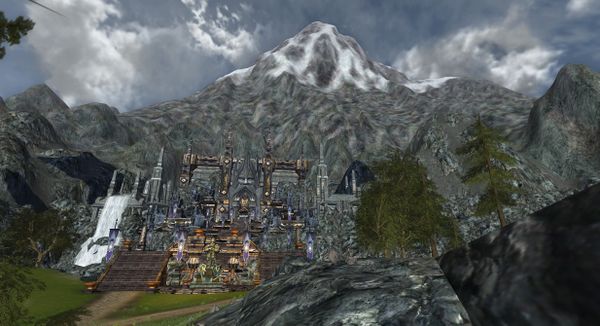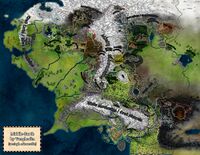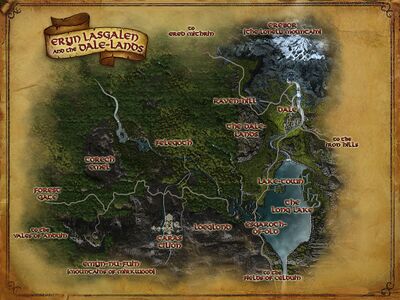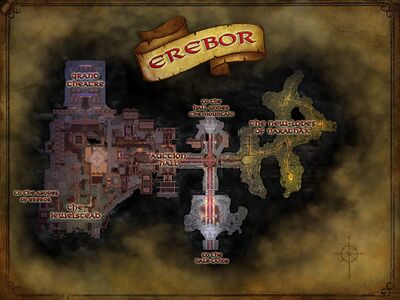Erebor
(Redirected from Lonely Mountain)
| Region: | Eryn Lasgalen and the Dale-lands |
| Settlement(s): | Hall Under the Mountain Tumnu-dûm, The Dwelling-halls |
| Connecting Area(s): |
The Dale-lands |
| Levels: | Mainly 115 |
| Resource tier: | T11 - Doomfold |

Description
Erebor, the Lonely Mountain, is an area within Eryn Lasgalen and the Dale-lands. It is the mountain that stands alone in the north of Rhovanion, to the east of Eryn Lasgalen and north of the Dale-lands, where the Dwarves founded the Kingdom of Erebor.
There are few services in the exterior of Erebor, but the Hall Under the Mountain within is the capital of Durin's Folk and has much to do.
Settlements
The following settlements are found within this area:
Locations
Travelling
| Mission Recruiter destinations | |||||||||||||||||||||||||||||||||||||||||||||||||||||||||||||||||||||||||||||||||||||||||||||||||||||||||||||||||||
|---|---|---|---|---|---|---|---|---|---|---|---|---|---|---|---|---|---|---|---|---|---|---|---|---|---|---|---|---|---|---|---|---|---|---|---|---|---|---|---|---|---|---|---|---|---|---|---|---|---|---|---|---|---|---|---|---|---|---|---|---|---|---|---|---|---|---|---|---|---|---|---|---|---|---|---|---|---|---|---|---|---|---|---|---|---|---|---|---|---|---|---|---|---|---|---|---|---|---|---|---|---|---|---|---|---|---|---|---|---|---|---|---|---|---|---|
| |||||||||||||||||||||||||||||||||||||||||||||||||||||||||||||||||||||||||||||||||||||||||||||||||||||||||||||||||||
NPCs
See "list of NPCs" within Erebor
- Dwarf
- Fregi
- Órug
- Stable-master
- Mission Recruiter
- Víglund - Erebor Guard
- Lági Helmbiter
- Reithvald Red-ember
- Uddvar
Quests
- [115] Ale-thieves - Snállar
- [115] Roots of Gold - Bráthi
- The Secret Stone Quests
- [115] The Secret Stone - Landscape
- [115] The Lost Pages
- [115] The Mad Dwarf
- [115] The Key and the Keyhole
- Under the Mountain
- [115] Under the Mountain
- [115] A King Lost, A King Gained
- [115] The Forsaken of Mordor
- [115] Carving Out A Home
- [115] Forged in Flames
- [115] Hunting the North
- [115] A Costly Journey
- [115] Ambassador to the King
- [115] Reforging a Kingdom
- [115] Essays of Old
- [115] The Ravens of the North
- [115] Forging Trust
- Trail of Rust
- For the other quests in this chain, see Category:Trail of Rust Quests.
- [115] Concerning Dragons
- [115] The Teeth of Scatha
- [115] Scatha's Legacy
- [115] Epilogue: Trail of Rust
- [115] Thorog's Legacy
- [115] Bregmor's Legacy
Maps

Lore
- The dwarf-kingdom founded by Thráin I after the loss of Khazad-dûm. The kingdom was destroyed by the dragon Smaug, but was refounded by Thráin's descendant Thorin II Oakenshield.
| :: The content of this section is based upon the Official Lore Entry in the LOTRO Lorebook (no longer on-line). |
Location: To the northeast of Mirkwood, at the source of the River Running Origins: Founded by Thráin of Durin's Folk Dates: Founded III 1999
Deserted III 2210
Refounded III 2590
Sacked by Smaug III 2770
Refounded once more III 2941Pronunciation: e'rebor Meaning: Literally "Lonely Mountain" Other names: Kingdom under the Mountain, Lonely Mountain
- Note: In fact, Erebor was probably not completely deserted between III 2210 and III 2590, but the royal house of Durin's Folk was removed, and the Longbeards were ruled from the Grey Mountains for this period of its history.
Dwarves of the Lonely Mountain
- The original home of the Longbeards, the Dwarves of Durin's Folk, had been the majestic mountain-city of Khazad-dûm. After dwelling there for many millennia, they were driven out by a Balrog, Durin's Bane, and scattered into the Wild as their ancient mansions fell into darkness. Their King, Náin I, had been slain by the Balrog, but his son Thráin I led many of the Longbeards away to the northeast. There he founded a new Dwarf-kingdom beneath the Lonely Mountain, Erebor above the Long Lake.
- The followers of Thráin I were the founding Dwarves of Erebor, but that first kingdom did not last long. Thráin's son Thorin I saw that most of his people were settling in the Grey Mountains, to the north and west of Erebor, and he moved the King's seat to be with his people there. It is unclear whether Erebor was completely abandoned at this time - it seems likely that at least some Dwarves remained - but the royal house was resettled in the far north, and remained there for five generations.
- After King Dáin I was slain by a Dragon, his heir Thrór determined to lead the Longbeards back to Erebor, and refound the Kingdom under the Mountain. In his time the Dwarves of the Lonely Mountain reached the height of their wealth and fame. News of that wealth reached ears of the Dragon Smaug, who descended on the Lonely Mountain and claimed it for himself: yet again the Longbeards were driven out of their home into the wilderness.
- Eventually, the wandering Dwarves settled far to the west, in the Ered Luin, where they plotted vengeance on the Dragon Smaug. It was Thrór's grandson Thorin Oakenshield who finally achieved this, with the help of the Wizard Gandalf and Bilbo Baggins. Thorin himself did not survive long enough to rebuild his grandfather's kingdom: he was slain in the Battle of Five Armies. His cousin Dáin Ironfoot, who had led the Dwarves of the Iron Hills, became the new lord of the Lonely Mountain, and ruled there as King Dáin II until the time of the War of the Ring. Dáin was slain in that war, but the Kingdom under the Mountain survived, and the Dwarves still dwelt there as the Fourth Age dawned. [3]
- ↑ While the stable-master route denotes The Steepset, aka Zidir-nesad, which is in a level 131-140 area of Mattugard in Gundabad, in actual fact the endpoint is the Hall of Vérnozal, which is a mission hub and closed off from the Steepset area, unless the character is sufficiently-high level to pass through the connecting portal.
- ↑ This description of Erebor is taken from the Official Lore Entry in the LOTRO Lorebook (no longer on-line).
- ↑ https://www.glyphweb.com/arda/d/dwarvesofthelonelymountain.html
The Battle of Five Armies and the Dwarves of Erebor
Tremors Under the Mountain
- The history of Middle-earth has shifted in many places, few so important as the Lonely Mountain. Though the Battle of Five Armies happened long before the War of the Ring, its impact on Sauron’s forces was tremendous. Even with Smaug – who surely would have been an ally in the wars to come – slain, the Dark Lord lost a great deal of time and power with the defeat the goblins of Gundabad. Even a partial defeat would have left him with strength in the north of Rhovanion, enough that he might have later overpowered the defenders of Dale and Erebor in the battles there. The utter destruction of his forces, however, spurred by Bolg’s rash hunger to avenge the Great Goblin, meant he had to commit the Orcs of Dol Guldur and a goodly portion of the Easterlings in his service to the northern front. This would have ramifications in his war, for his strength the assaults on Lórien and Gondor was thus reduced. His forces were not spread thin, but those Orcs and Easterlings may well have been able to turn the tide in his favor, and even press on into Rohan and Isengard.
- A goblin victory, of course, would have been even worse. Had Erebor fallen – a strong possibility if the enmities of Man, Elf, and Dwarf not been set aside that day, or if the Eagles and Beorn had not arrived when they did – there would have been no northern front, and Rhovanion would have become a stronghold from which he could launch assaults on the lands to the south and west. In addition to Lórien, he might have been able to take Rivendell, and with the aid of Angmar, the lands of the Dúnedain and the Shire. The war may well have begun much earlier, and Sauron’s agents may have claimed the Ring from Bilbo Baggins long before Gandalf learned the truth about it. Middle-earth would have been crushed beneath his heel.
- Luckily (or by the grace of the Valar) this did not come to pass. This was in no small part because of the valor of the Dwarves, especially Thorin Oakenshield, who fell in the battle, and his cousin Dáin, who survived to be crowned King Under the Mountain. Others, too, became heroes in the course of the battle, and went on to great deeds, for both good and ill. Balin went on to reclaim the halls of Moria, to a disastrous end that helped to stir up Orcs and darker things there (but which led, in the end, to the death of Gandalf the Grey and his rebirth with even greater power as the White, which surely helped turn the tide of the war). Dwalin became lord of Ered Luin, and helped oppose Skorgrím Dourhand in a struggle which ultimately broke the power of Angmar and finished crippling the Enemy in the North. And Glóin became Dáin’s emissary, an Elf-friend whose son Gimli aided the Ringbearer and helped bring about needed victories in Rohan and Gondor. The sons of Bifur and Bofur formed the Iron Garrison, which established a new colony in Khazad-dûm. Even Bombur, though no longer able to walk because of his ever-spreading girth, became an incredibly rich and respected benefactor beneath the Mountain.
- Dáin’s last victory came in the War of the Ring itself, when he fell in battle against the Orcs and Easterlings Sauron sent to destroy Erebor and Dale. His sacrifice helped carry the day, but it also left a void that would prove nigh-impossible to fill. Though his son, Thorin III, was a mighty warrior in his own right, many Dwarves immediately considered him a lesser King than his forebears. His is a hard lot, for how could he hope to aspire to match his own father’s glory, or that of Thorin Oakenshield? Even his epithet, Stonehelm, became a curse because some feel he used the Mountain for protection rather than storming out from its gates as his namesake did in days of old. Thus, while the Battle of Five Armies helped save Middle-earth from Sauron, its legacy has made the crown heavy indeed upon the brow of its current King. Those who remain faithful to him now face a difficult struggle to keep the whispers of the unfaithful from flaring into sedition and revolt, and to securing his repute and his place on the throne.
| Settlements, Areas and Landmarks of Eryn Lasgalen and the Dale-lands
| ||
|---|---|---|
| Areas: | The Abodes of Erebor • The Dale-lands • Eryn Lasgalen • Long Lake | |
| Settlements: | Dale • Erebor • Felegoth • Lake-town • Loeglond | |
| Landmarks: | The Dale-lands: Bendburn • The Bones of Smaug • Bridgethorp • Eldby • Esgaroth-of-old • Garthness • Great-keep • Grytgate • Old Side Door • Ravenhill • Refugee Camps • Stranding • Tay Yoldash • Urûshoba • Wardman's Way Erebor: The New-lodes of Narathâk • Tumnu-dûm |
|
| Interiors: | Agshar-mazal • Akrâz-zahar • Burnwater House • Dale Crafting Hall • Dale-folk House • The Dragonbone Inn • Great-keep • Hall Under the Mountain • Lake-town Barracks • Lake-town Trading Hall • Mazal Akrâz • Mesem-azhâr • Nabgûn-mazaru • Nori's Home • The Jolly Bell • The Master's Manor • Trade Commission Headquarters • Warehouse • Ûdar-zahari | |
| Instances: | The Road to Erebor: The Bells of Dale • The Battle for Erebor • The Fires of Smaug • Flight to the Lonely Mountain | |

